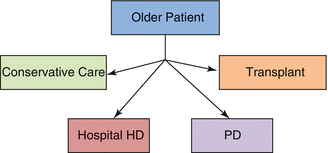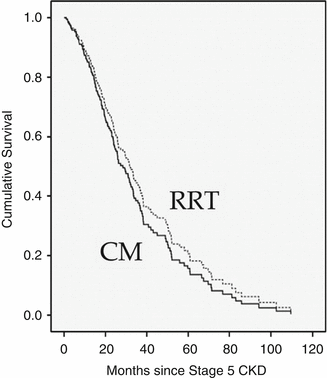and Christopher Isles2
(1)
Institute of Cardiovascular and Medical Sciences, University of Glasgow, Glasgow, UK
(2)
Dumfries and Galloway Royal Infirmary, Dumfries, UK
Q1 Describe the treatment options for elderly patients.
In theory all patients with established renal failure have the option of hospital haemodialysis, home haemodialysis, peritoneal dialysis, transplantation or conservative care (Fig. 43.1). In practice, no Scottish patients over the age of 80 years are currently being treated by home haemodialysis. There is no theoretical reason why an elderly renal patient should not have a pre-emptive transplant though this also does not happen. If a trial of renal replacement therapy is chosen, this effectively means a choice between hospital based haemodialysis and peritoneal dialysis at home. Studies suggest that with appropriate multidisciplinary support, over 50 % of an elderly population eligible for PD will choose this form of treatment. However, the uptake is much lower. A UK Renal Registry analysis of patients under 65 years on 31/12/2012 showed that 63 % had a functioning transplant, 31 % were treated by haemodialysis, and only 6 % were undergoing PD. In the over 65s the proportion with a functioning transplant dropped to 27 % with most of the remaining patients receiving haemodialysis (64 %) rather than PD (9 %).


Fig. 43.1
Treatment modalities for older patients
Q2 When should you consider conservative care as a treatment option?
We believe conservative care is an important treatment option for all patients over 80 years of age and that it may also be the correct decision for younger patients if they are frail or have multiple comorbid illnesses. This is not to say that patients over 80 years of age cannot dialyse successfully, but to recognise that patients aren’t obliged to dialyse if after careful consideration of the pros and cons they choose not to. Frailty and comorbidity occur more commonly in the elderly, and for many frail, comorbid elderly patients renal replacement therapy may just prove to be too demanding.
Q3 How well does serum creatinine predict the need for dialysis in the elderly?
Less well than in a younger person. For a given level of serum creatinine, GFR will always be lower in the elderly, especially if underweight. In these circumstances the Cockcroft Gault equation may well give a more precise estimate of residual function than the MDRD formula (because the Cockcroft Gault takes body weight into account). For example, an 80 year old woman who has a serum creatinine of 300 umol/l and weighs 50 kg will have a creatinine clearance of 10 ml/min. By contrast a 50 year old man with the same level of creatinine who weighs 80 kg will have a clearance of 30 ml/min. The elderly underweight woman has end stage kidney disease while her younger male counterpart clearly does not.


Q4 Why do more elderly patients choose hospital haemodialysis than PD?
It is likely that physical problems, social circumstances and cognitive impairment conspire to make PD less attractive in the elderly. This is ironic given that in a recent UK study scores estimating the intrusion of therapy and quality of life were found to be better in PD patients than in those who received haemodialysis. Some units may promote PD more than others as judged by a fourfold variation in uptake between units reported to the UK Renal Registry in 2012.
Q5 How might the uptake of PD be increased in the elderly?
A recent development has been assisted automated PD. Automated PD allows the patient to be treated at night with a portable machine that pumps fluid in and out of their peritoneal cavity automatically. With assisted APD a fully trained healthcare assistant visits daily – emptying drainage bags, checking drained fluid for cloudiness, setting up the machine for the next treatment, inspecting the catheter exit site and reviewing stocks of treatment fluids and drugs. These assistants maintain contact with the parent unit which intervenes if problems arise.
Q6 By how much does dialysis increase survival in the elderly?
A recent report from the Lister Unit in the UK revisited the survival of elderly CKD patients in a non-randomised study. Eighty-two percent were treated by RRT while 18 % received conservative management. Survival was calculated from the first recorded eGFR of <15 ml/min rather than from the onset of dialysis, and adjusted for comorbidity. The survival advantage associated with dialysis fell to 4 months when subjects aged 75 years were analysed separately (Fig. 43.2). The take home message from this paper was that elderly patients who receive renal replacement therapy are only likely to achieve a worthwhile survival advantage if they have low co-morbidity.
 < div class='tao-gold-member'>
< div class='tao-gold-member'>





Only gold members can continue reading. Log In or Register to continue
Stay updated, free articles. Join our Telegram channel

Full access? Get Clinical Tree








